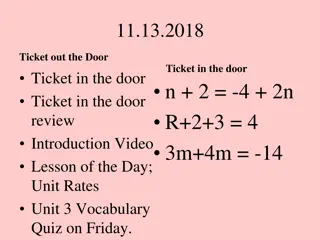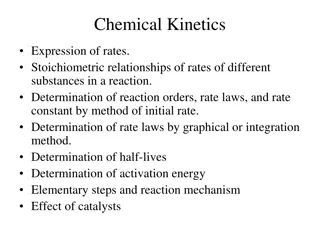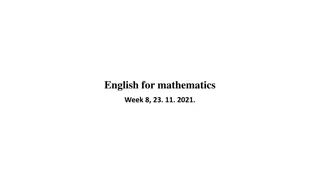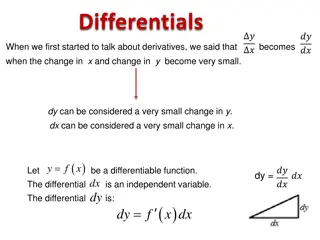Understanding Unit Rates in Mathematics
Explore the concept of unit rates in mathematics, where you will learn how to determine unit rates of given quantities and solve word problems involving unit rates. Discover key vocabulary, such as ratio, rate, and terms, and understand the difference between ratio and rates. Delve into examples and sample problems to grasp the essence of unit rates effectively.
Download Presentation

Please find below an Image/Link to download the presentation.
The content on the website is provided AS IS for your information and personal use only. It may not be sold, licensed, or shared on other websites without obtaining consent from the author. Download presentation by click this link. If you encounter any issues during the download, it is possible that the publisher has removed the file from their server.
E N D
Presentation Transcript
Unit Rate Unit 1 Lesson 2 Math 6
Unit Rates Students will be able to: Determine the unit rate of the given quantities. Solve word problems involving unit rates.
Unit Rate Key Vocabulary: Ratio Rate Unit Rate Terms
Unit Rate Ratio vs. Rates Ratio is the comparison of two numerical measurements. Each measurement is called a "term." The ratio of bananas to apples is 2:5
Unit Rate Rate is a little bit different than the ratio, it is a special ratio. It is a comparison of measurements that have different units. Example: If 15 burgers cost $75, the rate is $75 for 15 yummy burgers. In ratio: $75 : 15
Unit Rate In the example, the first term of the ratio is the price in dollars and the second term is the number of burgers. You can write this rate as $75/15 burgers or $75:15 burgers. Both expressions mean that you pay $75 "for every" 15 burgers.
Unit Rate Sample Problem 1: Tell whether the given quantities represent a mere RATIO or a RATE. a. 10 pieces of red pens to 6 pieces of blue pens Solution: RATIO b.200 miles to 4 hours Solution: RATE
Unit Rate Unit Rate is a rate in which the second term equals "1." If you want you determine a unit rate, you need to know how much of the first term exists for every one unit of the second term
Unit Rate Unit Rate Example: Here, the rate is $2.49 for every kilo of tomatoes, or in ratio $2.49:1.
Unit Rate Unit Rate Notice that the value of the second term in the ratio is 1. Therefore, when rates are expressed as a quantity of 1, then the rate $2.49 per kilois a unit rate.
Unit Rate Unit Rate And since ratios can be expressed as fractions, it is also CORRECT to say that a unit rate has 1 as the denominator.
Unit Rate Sample Problem 2: Which among the given quantities express a unit rate? a. 90 words per 30 minutes b.3 words per minute c. 180 words per hour d.60 words per 20 minutes
Unit Rate How Do We Calculate the Unit Rate? Step 1: Check what information is given. The problem must have two terms, and you must be asked to determine how much of one term exists per unit of the other term.
Unit Rate How Do We Calculate the Unit Rate?
Unit Rate Example: A bakeshop can bake 400 chocolate cupcakes in an 8 hour work day. How many chocolate cupcakes can that same bakeshop make in one hour?
Unit Rate In other words, how many chocolate cupcakes are typically baked per hour?
Unit Rate Step 2: Rewrite the given date as a quotient or a fraction.
Unit Rate Step 3: Divide the first term (numerator) and the second term (denominator) by the value of the denominator. Remember that we want to express the rate as a SINGLE unit which means that the denominator MUST be equal to 1.
Unit Rate Step 4: Write the unit rate expression. Therefore, the bakeshop can bake 50 chocolate cupcakes per hour.
Unit Rate Sample Problem 3: Answer the problem. James traveled 200 miles in 4 hours. If he used the same speed the entire trip, how fast did he drive miles per hour?
Unit Rate Solution: Step 1: 200 miles in 4 hours Step 2: 200 ????? 4 ???? Step 3: 200 miles / 4 = 50 4 hours / 4 = 1 Step 4: Therefore, he drives 4 miles per hour.

















































